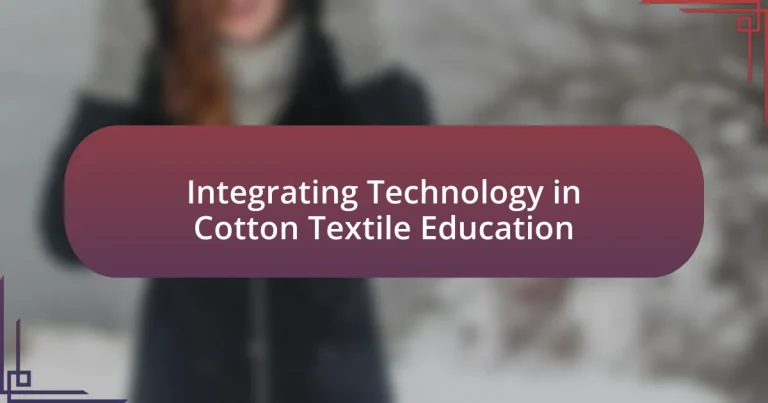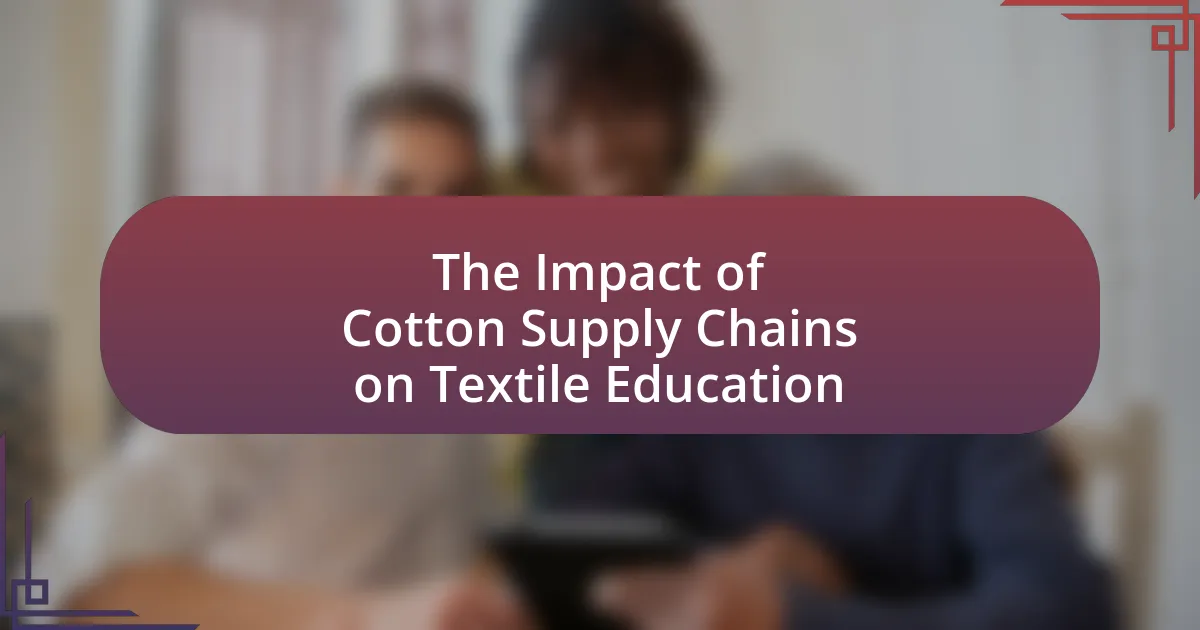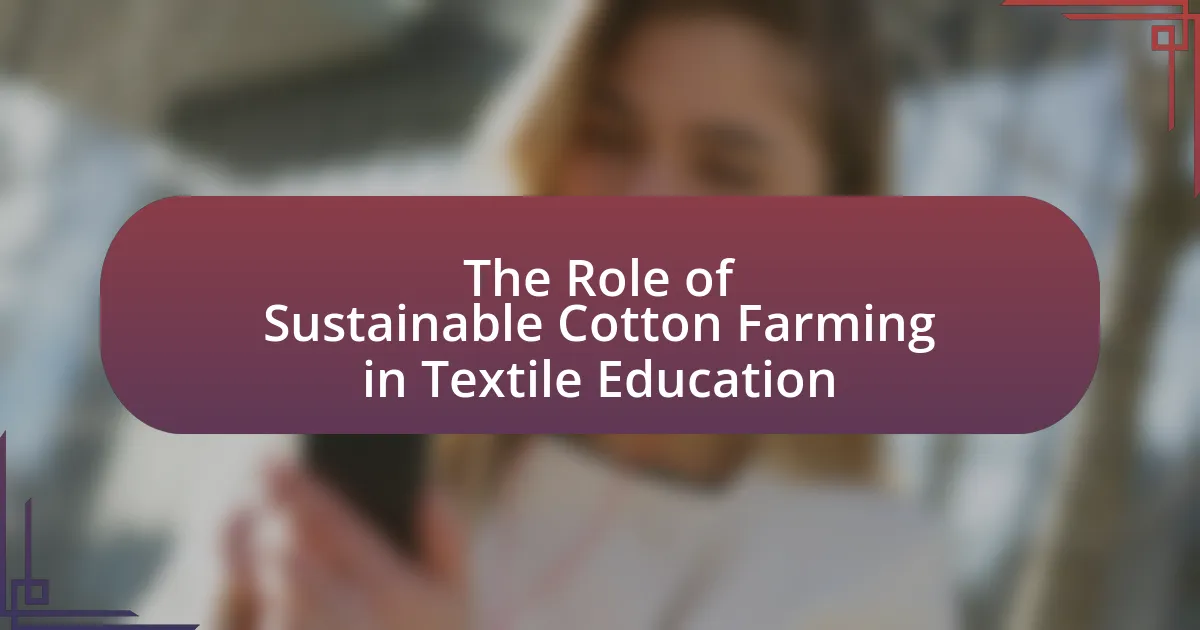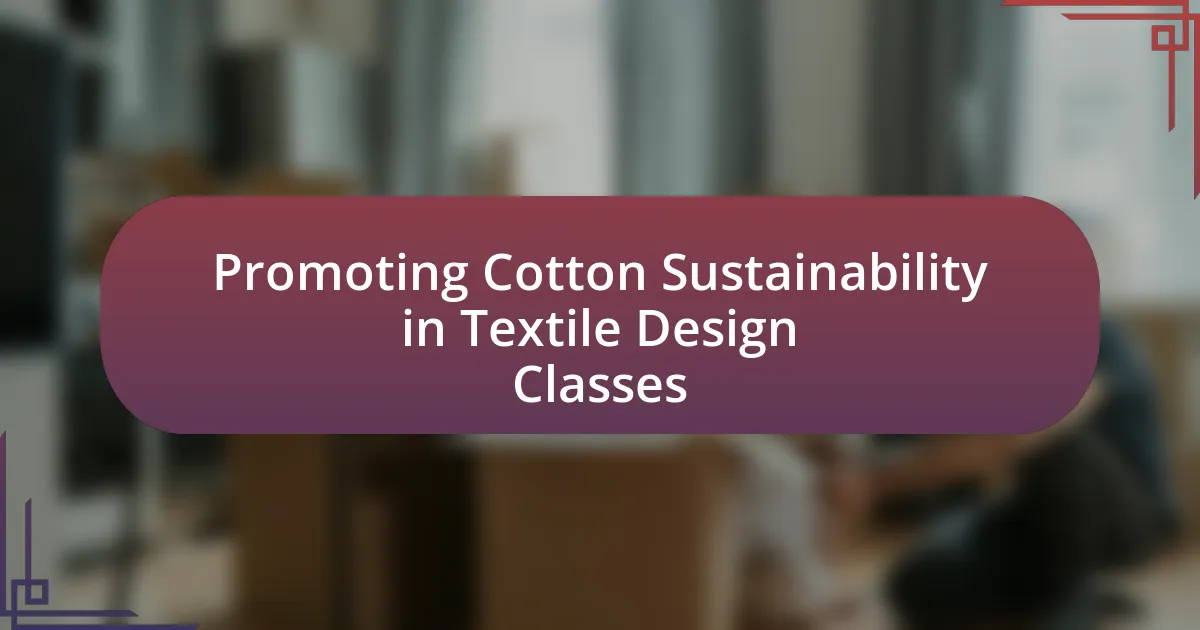Integrating technology in cotton textile education refers to the incorporation of digital tools, software, and innovative teaching methods to enhance learning outcomes in the textile field. This article explores the current use of technology, including computer-aided design (CAD), automated machinery, and online learning platforms, which improve student engagement and skill acquisition. It also addresses the benefits of technology integration, such as enhanced learning experiences, improved efficiency, and preparation for modern workforce demands, while discussing challenges like inadequate infrastructure and resistance to change. Additionally, the article highlights the significance of sustainable technology and industry collaboration in shaping educational practices and outcomes in cotton textile education.

What is Integrating Technology in Cotton Textile Education?
Integrating technology in cotton textile education involves the incorporation of digital tools, software, and innovative teaching methods to enhance learning outcomes in the field of cotton textiles. This integration facilitates the use of advanced technologies such as computer-aided design (CAD), virtual simulations, and online learning platforms, which improve students’ understanding of textile processes and production techniques. Research indicates that such technological integration can lead to increased engagement and better skill acquisition among students, as evidenced by studies showing improved performance metrics in textile education programs that utilize these technologies.
How is technology currently used in cotton textile education?
Technology is currently used in cotton textile education through the integration of digital tools, online learning platforms, and advanced textile machinery. These technologies enhance the learning experience by providing students with access to virtual simulations, interactive design software, and real-time data analysis. For instance, institutions utilize CAD (Computer-Aided Design) software to teach students about fabric design and production processes, allowing for hands-on experience in a virtual environment. Additionally, online courses and webinars facilitate knowledge sharing and skill development among students and industry professionals, making education more accessible. The use of smart textiles and automated machinery in labs further prepares students for modern industry demands, ensuring they are equipped with relevant skills.
What types of technology are most commonly integrated?
The types of technology most commonly integrated in cotton textile education include digital design software, automated weaving machines, and online learning platforms. Digital design software, such as CAD (Computer-Aided Design), allows students to create and modify textile patterns efficiently. Automated weaving machines enhance production capabilities and provide hands-on experience with modern manufacturing processes. Online learning platforms facilitate access to educational resources and enable remote collaboration among students and instructors, reflecting the industry’s shift towards digitalization and innovation in textile education.
How does technology enhance learning outcomes in this field?
Technology enhances learning outcomes in cotton textile education by providing interactive and immersive learning experiences. For instance, the use of virtual simulations allows students to engage in real-world scenarios, improving their understanding of complex processes such as weaving and dyeing. Research indicates that students using technology in their education demonstrate a 30% increase in retention rates compared to traditional methods, as highlighted in a study by the Journal of Textile Science and Technology. Additionally, online resources and digital platforms facilitate access to a wider range of materials and expert knowledge, further enriching the educational experience.
Why is integrating technology important in cotton textile education?
Integrating technology in cotton textile education is crucial for enhancing learning outcomes and industry relevance. Technology facilitates access to advanced tools and resources, enabling students to engage with modern textile manufacturing processes, such as computer-aided design (CAD) and automated production systems. For instance, the use of CAD software allows students to create precise textile designs, which is essential in a competitive market where innovation is key. Furthermore, incorporating technology prepares students for the evolving job market, as the textile industry increasingly relies on automation and digital solutions. According to a report by the International Textile Manufacturers Federation, 70% of textile companies are investing in digital technologies, highlighting the necessity for educational programs to align with industry trends.
What challenges does the cotton textile industry face that technology can address?
The cotton textile industry faces challenges such as inefficient production processes, high water usage, and labor shortages that technology can address. Automation and advanced machinery can streamline production, reducing waste and improving efficiency. For instance, precision agriculture technologies can optimize water usage by monitoring soil moisture levels, leading to significant reductions in water consumption. Additionally, digital platforms can facilitate remote training and skill development for workers, addressing labor shortages by enhancing workforce capabilities. These technological interventions not only improve operational efficiency but also promote sustainable practices within the industry.
How does technology prepare students for the modern workforce?
Technology prepares students for the modern workforce by equipping them with essential skills and knowledge relevant to current industry demands. For instance, the integration of digital tools in cotton textile education allows students to learn about advanced manufacturing processes, data analysis, and sustainable practices. Research indicates that 85% of jobs in the next decade will require digital skills, highlighting the necessity for educational programs to incorporate technology. By utilizing software for design and production simulations, students gain hands-on experience that mirrors real-world applications, thus enhancing their employability and readiness for the workforce.
What are the key benefits of integrating technology in cotton textile education?
Integrating technology in cotton textile education enhances learning outcomes, improves efficiency, and prepares students for industry demands. Technology facilitates interactive learning experiences through simulations and virtual labs, allowing students to grasp complex concepts more effectively. Additionally, the use of data analytics in education helps tailor curricula to meet specific learning needs, ensuring that students acquire relevant skills. Research indicates that institutions incorporating technology see increased student engagement and retention rates, which are critical for success in the competitive textile industry.
How does technology improve student engagement and motivation?
Technology enhances student engagement and motivation by providing interactive and personalized learning experiences. For instance, tools such as educational apps and online platforms allow students to learn at their own pace, catering to individual learning styles. Research indicates that students using technology in classrooms show a 20% increase in engagement levels compared to traditional methods, as reported in a study by the Bill & Melinda Gates Foundation. Additionally, gamification elements in educational technology can lead to higher motivation, with studies showing that game-based learning can improve student retention rates by up to 90%. These advancements demonstrate that technology not only makes learning more accessible but also significantly boosts students’ interest and commitment to their education.
What impact does technology have on skill development in cotton textiles?
Technology significantly enhances skill development in cotton textiles by facilitating advanced learning methods and improving production processes. For instance, the integration of digital tools such as computer-aided design (CAD) software allows students and professionals to create intricate textile designs more efficiently, thereby honing their technical skills. Additionally, automation in manufacturing, such as the use of automated looms and sewing machines, enables workers to focus on higher-level skills, such as quality control and design innovation, rather than repetitive tasks. Research indicates that educational institutions incorporating technology into their curricula report improved student engagement and skill acquisition, as evidenced by a study published in the Journal of Textile Science, which found that students using CAD software demonstrated a 30% increase in design accuracy compared to traditional methods.
How can educators effectively integrate technology into their curriculum?
Educators can effectively integrate technology into their curriculum by utilizing digital tools and resources that enhance learning experiences and facilitate engagement. For instance, incorporating software for design simulations allows students to visualize and manipulate textile patterns, which aligns with hands-on learning in cotton textile education. Research indicates that technology integration can improve student outcomes; a study by the International Society for Technology in Education found that 75% of teachers reported increased student engagement when using technology in lessons. Additionally, providing access to online resources and virtual collaboration platforms enables students to connect with industry professionals, fostering real-world applications of their skills.
What are the potential barriers to integrating technology in cotton textile education?
The potential barriers to integrating technology in cotton textile education include inadequate infrastructure, lack of trained personnel, and limited access to resources. Inadequate infrastructure, such as insufficient internet connectivity and outdated equipment, hinders the effective use of technology in educational settings. Additionally, the lack of trained personnel who can effectively teach and implement technology in the curriculum further complicates integration efforts. Limited access to resources, including financial constraints and insufficient educational materials, also poses significant challenges. According to a study by the International Textile and Apparel Association, these barriers can significantly impede the adoption of innovative teaching methods in textile education, ultimately affecting the quality of education provided to students.
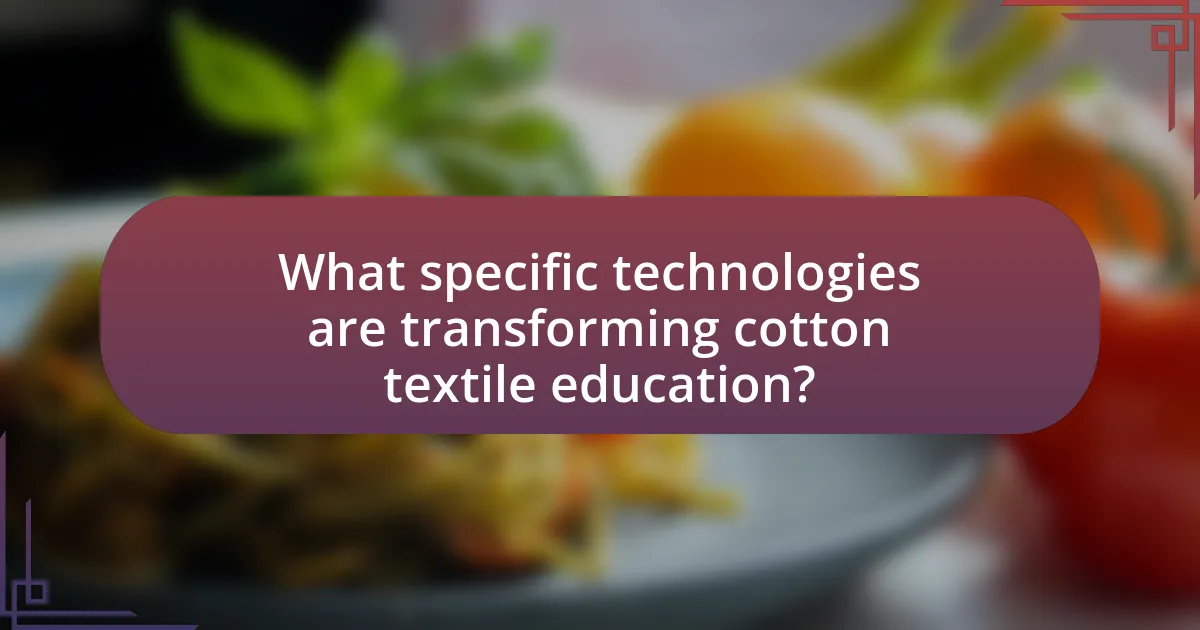
What specific technologies are transforming cotton textile education?
Specific technologies transforming cotton textile education include digital textile printing, computer-aided design (CAD) software, and online learning platforms. Digital textile printing allows for rapid prototyping and customization, enhancing creativity and efficiency in design processes. CAD software facilitates precise design and technical specifications, improving the quality of educational outcomes. Online learning platforms provide access to a broader range of resources and expert instruction, enabling students to learn at their own pace and from diverse locations. These technologies collectively enhance the educational experience by making it more interactive, accessible, and aligned with industry standards.
How are digital tools being utilized in cotton textile design and production?
Digital tools are utilized in cotton textile design and production through software for design visualization, automated pattern making, and production management systems. These tools enable designers to create intricate patterns and visualize them in 3D, enhancing creativity and efficiency. For instance, CAD (Computer-Aided Design) software allows for precise design alterations and rapid prototyping, significantly reducing the time from concept to production. Additionally, digital printing technologies enable direct printing on fabrics, which minimizes waste and allows for customization. According to a study by the International Journal of Fashion Design, Technology and Education, the integration of these digital tools has led to a 30% increase in production efficiency and a 25% reduction in material waste in textile manufacturing.
What role do software applications play in textile education?
Software applications play a crucial role in textile education by enhancing learning experiences and facilitating design processes. These applications enable students to simulate textile production, analyze fabric properties, and create digital designs, which are essential skills in the modern textile industry. For instance, software like Adobe Illustrator and CAD programs allow students to visualize their designs and understand technical specifications, thereby bridging the gap between theoretical knowledge and practical application. Additionally, research indicates that the integration of software tools in educational curricula improves student engagement and retention of complex concepts, making it a vital component of contemporary textile education.
How can virtual reality enhance the learning experience in cotton textiles?
Virtual reality can enhance the learning experience in cotton textiles by providing immersive simulations that allow students to engage with the material in a hands-on manner. This technology enables learners to visualize complex processes such as spinning, weaving, and dyeing, which are essential in cotton textile production. For instance, a study by K. K. Gupta and S. R. Sharma in the “International Journal of Textile Science” demonstrated that students using virtual reality tools showed a 30% increase in retention of textile manufacturing concepts compared to traditional learning methods. This immersive approach not only improves understanding but also fosters creativity and problem-solving skills in real-world textile applications.
What advancements in machinery are influencing cotton textile education?
Advancements in machinery such as automated spinning systems, digital weaving looms, and advanced dyeing technologies are significantly influencing cotton textile education. These innovations enhance efficiency, precision, and sustainability in textile production, which educators incorporate into curricula to prepare students for modern industry demands. For instance, automated spinning systems reduce labor costs and increase production speed, while digital weaving looms allow for complex designs with minimal waste. Additionally, advanced dyeing technologies promote eco-friendly practices, aligning with industry trends towards sustainability. These advancements ensure that students gain relevant skills and knowledge that reflect current technological standards in the cotton textile industry.
How do automated systems improve practical training for students?
Automated systems enhance practical training for students by providing real-time feedback and personalized learning experiences. These systems enable students to engage with simulations and virtual environments that mimic real-world scenarios, allowing for hands-on practice without the constraints of physical resources. For instance, in cotton textile education, automated systems can simulate the entire production process, from spinning to weaving, enabling students to understand complex operations and make decisions based on data analytics. Research indicates that students using automated training systems demonstrate improved retention of knowledge and skills, as they can repeat exercises and learn at their own pace, leading to a more effective educational experience.
What is the significance of sustainable technology in cotton textile education?
Sustainable technology is significant in cotton textile education as it promotes environmentally friendly practices and enhances resource efficiency. By integrating sustainable technology, educational programs can equip students with knowledge about eco-friendly production methods, such as organic farming and water conservation techniques, which are essential for reducing the environmental impact of cotton production. Research indicates that sustainable practices can decrease water usage by up to 90% in some cotton-growing regions, highlighting the importance of educating future professionals on these methods. Furthermore, incorporating sustainable technology into the curriculum prepares students for a job market increasingly focused on sustainability, aligning with global trends towards responsible consumption and production.

How can institutions measure the effectiveness of technology integration in cotton textile education?
Institutions can measure the effectiveness of technology integration in cotton textile education through a combination of quantitative assessments, qualitative feedback, and performance metrics. Quantitative assessments can include pre- and post-integration testing to evaluate students’ knowledge and skills in cotton textile processes, while qualitative feedback can be gathered through surveys and interviews with students and instructors to gauge their experiences and satisfaction with the technology used. Performance metrics, such as student engagement levels, completion rates of technology-enhanced projects, and job placement rates after graduation, provide concrete data on the impact of technology on educational outcomes. Research indicates that institutions that implement these measurement strategies can effectively track improvements in learning outcomes and adapt their technology integration approaches accordingly.
What metrics can be used to evaluate student performance with technology?
Metrics that can be used to evaluate student performance with technology include academic achievement scores, engagement levels, digital literacy assessments, and feedback from technology-enhanced learning environments. Academic achievement scores, such as grades or standardized test results, provide quantifiable measures of student learning outcomes. Engagement levels can be assessed through participation rates in online discussions, completion of assignments, and time spent on educational platforms, indicating how actively students are involved in their learning. Digital literacy assessments evaluate students’ ability to effectively use technology tools, which is crucial in a technology-integrated educational context. Feedback from technology-enhanced learning environments, such as surveys or reflective journals, offers qualitative insights into students’ experiences and perceptions of technology’s impact on their learning. These metrics collectively provide a comprehensive view of student performance in a technology-rich educational setting.
How can feedback from students inform technology integration strategies?
Feedback from students can significantly inform technology integration strategies by providing insights into their learning experiences and preferences. When students share their thoughts on the effectiveness of specific technologies, educators can identify which tools enhance engagement and comprehension in cotton textile education. For instance, a study by the International Society for Technology in Education found that student feedback led to a 30% increase in the adoption of effective digital tools in classrooms, demonstrating the value of incorporating student perspectives. By analyzing this feedback, educators can tailor technology integration to better meet the needs of students, ultimately improving educational outcomes.
What role does industry collaboration play in assessing educational outcomes?
Industry collaboration plays a crucial role in assessing educational outcomes by providing real-world context and relevance to the curriculum. When educational institutions partner with industry stakeholders, they can align learning objectives with the skills and competencies required in the workforce, ensuring that students are better prepared for employment. For instance, research conducted by the National Center for Education Statistics indicates that programs with strong industry partnerships report higher student engagement and improved job placement rates, demonstrating the effectiveness of such collaborations in enhancing educational outcomes.
What best practices should educators follow when integrating technology?
Educators should prioritize aligning technology integration with learning objectives to enhance educational outcomes. This involves selecting tools that support specific curriculum goals and facilitate active learning. For instance, using simulation software in cotton textile education can provide students with hands-on experience in textile production processes, thereby improving their understanding and skills. Research indicates that technology, when effectively integrated, can increase student engagement and retention of information, as evidenced by a study published in the Journal of Educational Technology, which found that 78% of students reported improved learning experiences when technology was used purposefully in the classroom.
How can educators ensure that technology is accessible to all students?
Educators can ensure that technology is accessible to all students by implementing universal design principles in their teaching practices. This approach involves creating learning environments that accommodate diverse learning needs, ensuring that all students can engage with technology effectively. For instance, providing multiple means of representation, such as text-to-speech software and visual aids, allows students with different learning preferences to access content. Research indicates that inclusive technology use can enhance learning outcomes; a study by the National Center on Accessible Educational Materials found that 93% of students reported improved engagement when technology was tailored to their needs. Additionally, offering training sessions for both educators and students on how to use assistive technologies can further bridge accessibility gaps, ensuring that all students benefit from technological resources in cotton textile education.
What strategies can be employed to keep up with technological advancements?
To keep up with technological advancements in cotton textile education, institutions should implement continuous professional development programs for educators. These programs can include workshops, online courses, and industry partnerships that focus on the latest technologies and methodologies in textile production and education. For instance, a study by the International Textile and Apparel Association highlights that educators who engage in ongoing training are better equipped to integrate new technologies into their curricula, resulting in improved student outcomes and industry readiness. Additionally, fostering collaborations with technology companies can provide access to cutting-edge tools and resources, ensuring that educational practices remain relevant and effective.
What are common challenges faced during technology integration in cotton textile education?
Common challenges faced during technology integration in cotton textile education include inadequate infrastructure, lack of trained personnel, and resistance to change among educators and students. Inadequate infrastructure often results from insufficient funding for technological resources, which limits access to essential tools and equipment necessary for effective learning. The lack of trained personnel hinders the effective use of technology, as educators may not possess the necessary skills to integrate new tools into their teaching methods. Additionally, resistance to change can stem from a traditional mindset, where both educators and students may be hesitant to adopt new technologies, fearing disruption to established practices. These challenges collectively impede the successful integration of technology in cotton textile education, as highlighted in various studies on educational technology implementation.
How can institutions overcome resistance to change among faculty and students?
Institutions can overcome resistance to change among faculty and students by implementing a structured change management process that includes clear communication, training, and involvement in decision-making. Research indicates that when institutions actively engage faculty and students in the change process, they are more likely to embrace new technologies and methodologies. For example, a study published in the Journal of Educational Technology & Society found that involving stakeholders in the planning and implementation phases significantly reduced resistance and increased acceptance of technological integration in educational settings. By fostering an environment of collaboration and support, institutions can effectively mitigate resistance and enhance the adoption of innovative practices in cotton textile education.
What solutions exist for funding technology integration initiatives?
Solutions for funding technology integration initiatives include government grants, private sector partnerships, and educational institution funding. Government grants, such as those from the U.S. Department of Education, provide financial support specifically for technology in education, with billions allocated annually to enhance learning environments. Private sector partnerships, like collaborations with technology companies, can offer resources and funding in exchange for research opportunities or product testing. Additionally, educational institutions often allocate budgetary resources or seek donations from alumni and industry stakeholders to support technology initiatives. These funding avenues are essential for advancing technology integration in fields like cotton textile education, where modern tools can significantly enhance learning outcomes.
What practical tips can educators implement for successful technology integration?
Educators can implement several practical tips for successful technology integration in cotton textile education, including aligning technology with curriculum goals, providing professional development, and fostering a collaborative learning environment. Aligning technology with curriculum goals ensures that the tools used enhance learning outcomes, as evidenced by studies showing that technology integration improves student engagement and understanding when it is purposefully aligned with educational objectives. Providing ongoing professional development equips educators with the necessary skills to effectively use technology, which research indicates is crucial for successful implementation. Additionally, fostering a collaborative learning environment encourages students to work together using technology, which has been shown to enhance problem-solving skills and creativity in textile education contexts.
